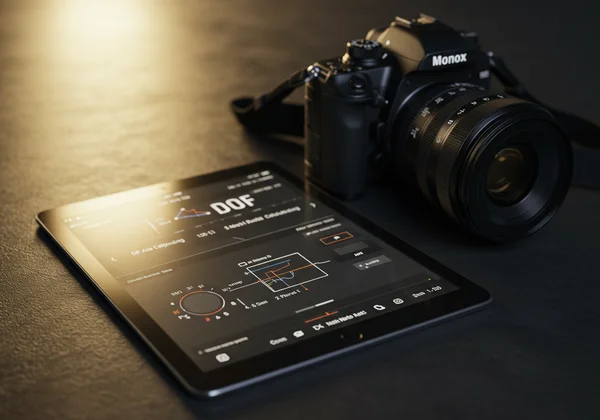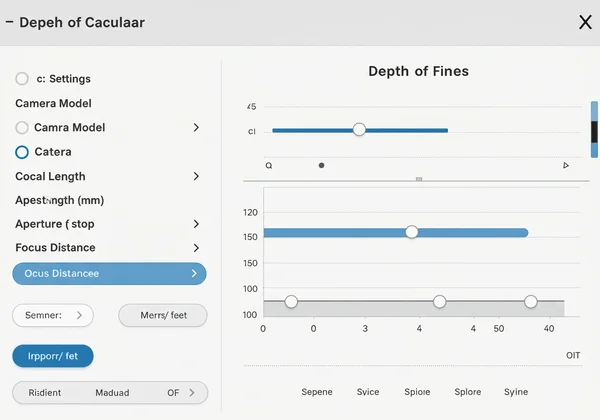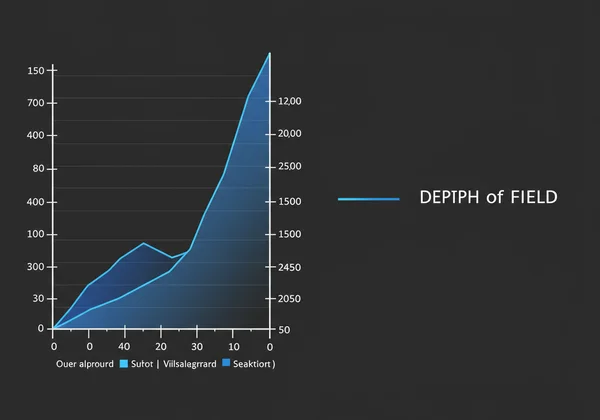Master Your Shots: DOF Calculator Workflow & Planning Guide
Ever captured a moment, only to find the key elements weren't quite sharp? Or perhaps you've struggled to achieve that dreamy, blurred background? As photographers, we've all been there. The secret to consistently perfect photographs lies not just in better gear, but in smarter planning, and that's exactly what our DOF calculator workflow is designed to help you achieve. How to calculate depth of field is no longer a mystery, but a tool you can command.

Whether you dream of creamy, out-of-focus backgrounds (bokeh) or expansive, edge-to-edge sharp landscapes, understanding and planning your Depth of Field (DOF) is crucial. This article will show you how to integrate our powerful and intuitive DOF Calculator into your pre-shoot planning, turning abstract numbers into predictable, stunning results.
Why a Photography Planning Tool is Essential for Your Workflow
In photography, preparation is the bridge between intention and execution. A great image rarely happens by accident. It’s the result of deliberate choices about light, composition, and focus. A reliable photography planning tool eliminates guesswork, saves valuable time on location, and empowers you to capture the exact image you have in your mind.
Visualize Success: The Power of Pre-Visualization in Photography
Ansel Adams famously said, "You don't take a photograph, you make it." This process of "making" begins with pre-visualization—seeing the final image in your mind's eye before you even press the shutter. A DOF calculator is the ultimate tool for this. It allows you to simulate how different combinations of camera settings will affect your final image. You can see, mathematically and visually, how a subtle change in aperture or focal length will either isolate your subject or deepen the scene's sharpness, allowing you to walk into a shoot with complete confidence in your technical setup.
Stop Guessing: Understanding Your DOF Before You Shoot
How often have you found yourself "chimping"—constantly checking your camera's tiny LCD screen—hoping you nailed the focus? This guesswork is inefficient and often leads to disappointment later. By understanding your depth of field beforehand, you replace hope with certainty. You will know precisely where your plane of focus begins and ends. Our focus calculator gives you the exact metrics, ensuring that what needs to be sharp is sharp, every single time.
How to Use the DOF Calculator: Your Step-by-Step Guide
Our goal was to create a tool that is as powerful for professionals as it is intuitive for beginners. Following this simple how to use dof calculator guide will make it an indispensable part of your creative process. The interface is designed for a seamless, real-time experience, providing instant feedback as you adjust your parameters.
Inputting Your Camera Settings for Accurate DOF Calculation
Accuracy starts with the right inputs. On the left side of the tool, you'll find the "Camera Settings" panel.

- Camera: Select your camera model from the extensive drop-down list. This automatically sets the correct sensor size and Circle of Confusion (CoC), a critical factor for precise calculations. For advanced users, you can also input a custom CoC.
- Focal Length (mm): Use the slider or type in the focal length of your lens. This is a key driver of your field of view and depth of field.
- Aperture (f-stop): Adjust the aperture value. You'll instantly see how smaller f-numbers (like f/1.8) create a shallow focus effect, while larger numbers (like f/16) increase the zone of sharpness.
- Focus Distance: Set the distance from your camera to your subject. You can easily switch between meters and feet for convenience.
Interpreting Results: Numbers, Graphs & Hyperfocal Distance
Once you've entered your settings, the magic happens on the right. The results are presented in two clear formats. The numerical data gives you the exact figures: Near Focus Limit, Far Focus Limit, Total Depth of Field, and the all-important Hyperfocal Distance. This is the closest distance at which you can focus while keeping objects at infinity acceptably sharp—a landscape photographer's best friend.
Below the numbers is our standout feature: the Depth of Field Visualization chart. This intuitive graph makes abstract data tangible. It shows your subject, the total area in focus (in blue), and the out-of-focus zones. This visual feedback is what truly separates planning from guessing, allowing you to instantly plan your shot with a clear understanding of the outcome.

Applying Adjustments for Desired Depth of Field Effects
This is where theory meets practice. The real power of the calculator is its ability to let you experiment. By tweaking the input parameters, you can tailor the depth of field to achieve specific creative goals for any genre of photography.
Crafting Shallow DOF for Stunning Portraits (Blurry Backgrounds)
To achieve that professional-looking portrait with a beautifully blurred background, you want a shallow depth of field. Using the tool, you can see how to accomplish this:
- Select a wide aperture (a low f-stop number, like f/1.4 or f/2.8).
- Use a longer focal length (e.g., 85mm or 135mm).
- Move closer to your subject.
By playing with these three factors in our lens simulator, you can find the perfect balance to make your subject pop from the background.
Maximizing Deep DOF for Pin-Sharp Landscapes (Everything in Focus)
For breathtaking landscapes, the goal is often the opposite: a deep depth of field where everything from the foreground flowers to the distant mountains is sharp.

- Select a narrow aperture (a high f-stop number, like f/11 or f/16).
- Use a wider focal length (e.g., 16mm or 24mm).
- Calculate and use the hyperfocal distance. Focus at this specific distance to maximize your sharp zone.
Our tool calculates this for you instantly, taking the complex math out of capturing perfectly sharp scenic shots.
Elevate Your Photography with Creative Depth of Field Decisions
Mastering the technical side of DOF is only the beginning. The next step is to use it for artistic expression. Our calculator is not just a technical utility; it's a tool for enhancing your creative depth of field choices. It frees you from the technical constraints so you can focus entirely on the story you want to tell.
Beyond the Formulas: Making Intentional Artistic Choices with DOF
Depth of field is a powerful compositional tool. A shallow focus can guide the viewer's eye, create a sense of intimacy, or simplify a busy scene. A deep focus can convey a sense of scale, place the subject within its environment, or create a powerful, immersive experience. Use the calculator to explore these "what-if" scenarios. What if you focused just behind your main subject? How would that change the story? This is how you develop a signature style.
Integrating the DOF Calculator into Your Complete Shoot Planning Routine
Make the DOF Calculator a non-negotiable step in your preparation. Before you pack your bag, take five minutes to run through your planned shots. This simple habit, part of a comprehensive shot planning guide, will save you hours of frustration in the field. You'll know exactly which lens to bring and what starting aperture to use. This level of preparation is what separates good photographers from great ones. Try the tool on your next photo idea and see the difference it makes.
Your Path to Perfectly Planned Photography
Mastering depth of field is a journey from technical uncertainty to creative control. By moving beyond guesswork and embracing a planned workflow, you empower yourself to capture images that perfectly match your artistic vision. The DOF Calculator is more than just a tool; it's your partner in pre-visualization, your guide to technical precision, and your key to unlocking new creative possibilities.
Stop leaving your best shots to chance. Integrate this workflow into your process, experiment with the settings, and watch your photography reach new heights of quality and consistency. Visit the DOF Calculator now to start planning your next masterpiece.
Frequently Asked Questions About DOF Planning & the Calculator
What is Depth of Field (DOF) in Photography and Why is it Important?
Depth of Field (DOF) refers to the range of distance in a photo that appears acceptably sharp. It's a crucial creative element because it controls what the viewer focuses on. A shallow DOF isolates a subject (like in a portrait), while a deep DOF keeps an entire scene sharp (like in a landscape).
How Does Aperture Affect Depth of Field, and How Can I See This with the Calculator?
Aperture has a direct, inverse relationship with depth of field. A wide aperture (low f-stop number like f/1.8) results in a shallow (small) DOF, blurring the background. A narrow aperture (high f-stop number like f/16) creates a deep (large) DOF, keeping more of the scene in focus. You can see this effect in real-time on our free online tool by simply moving the aperture slider and watching the visualization chart change.
Can the DOF Calculator Help Me Get a Blurry Background for My Portraits?
Absolutely. This is one of its most popular uses. To get a blurry background, you need a shallow depth of field. The calculator will guide you to the right settings: use a wide aperture (low f-stop), a longer focal length, and get closer to your subject. Our tool lets you simulate these settings to see exactly how much background blur you can achieve before you even take the shot.
What is Hyperfocal Distance, and How Does Your Tool Help Me Achieve it for Sharp Landscapes?
Hyperfocal distance is a specific focus distance that gives your photos the greatest possible depth of field, making it invaluable for landscape photography. When you focus at this distance, your sharp range extends from half the hyperfocal distance all the way to infinity. Our hyperfocal distance calculator computes this precise distance for you based on your camera and settings, eliminating complex manual calculations.
How Does Focal Length Impact Depth of Field Calculations?
Focal length significantly impacts depth of field. Generally, longer focal lengths (telephoto lenses, e.g., 200mm) produce a much shallower depth of field than shorter focal lengths (wide-angle lenses, e.g., 24mm), even at the same aperture and focus distance. This is why telephoto lenses are great for isolating subjects and wide-angle lenses are ideal for capturing expansive, sharp scenes.